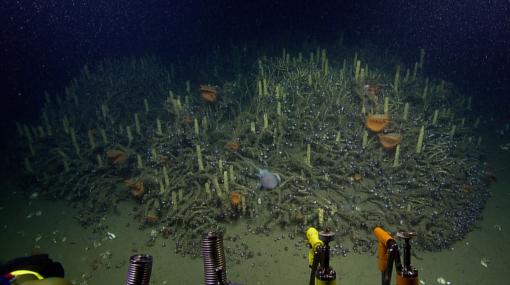Biology
Life in the deep sea is beautiful, unfamiliar, and awe-inspiring. Much of Nautilus' biological research focuses on communities that are all three -- chemosynthetic ecosystems. Unlike most ecosystems on land and in shallow waters, these communities are not based around sunlight or photosynthesis. Instead, bacteria transform chemicals released by geological processes in the Earth's crust into energy through a process called chemosynthesis. These bacteria form the base of an ecosystem that can include far more complex creatures, like giant tubeworms measuring up to several meters long, mussels with gills packed full of bacteria, and shrimp that swarm near boiling hot water.

As technology improves, so has our ability to locate chemosynthetic ecosystems like hydrothermal vents and methane seeps. Hydrothermal vents are fissures in the Earth's surface that spew superheated, mineral-rich water much like geysers fueled by volcanoes! The first vents were found in the late 1970s and now, in recent years, hundreds of new seeps are being discovered. Nautilus has examined many of these communities in locations found around the world, ranging from the Eratosthenes Seamount in the Mediterranean to the Galapagos volcanic rift in the eastern Pacific Ocean.
Another major area of research is focused on deep sea corals and sponges. Some coral work has looked at the effects of the 2010 Deepwater Horizon Oil Spill. Scientists working aboard Nautilus from Ecosystem Impacts of Oil and Gas in the Gulf (ECOGIG) have returned to the same coral sites every year since the spill to study the long-term effects of the oil on the coral and their associated communities. They are also noting the effects of natural gas seeps on corals to better understand what might make some more resistant to oil spills than others.

Cruises within national marine sanctuaries in the U.S. also focus on discovering coral and sponge communities located within their boundaries. Fish and invertebrates, both larvae and adults, can find structural complexity within these habitats, which provides shelter from predators, suspension-feeding positions higher in the water column, and protected living spaces. These fish include species important to fisheries management that use coral and sponge communities as a place to replenish their populations and brood their young. Invertebrates frequently found in these habitats include crustaceans, gastropods, brittle stars, basket stars, crinoids, and polychaetes – all of which may become prey for larger predators within the ecosystem. Corals are very long-lived and their skeletons can reflect past sea conditions, which allows scientists to investigate how changing climates may affect deep-sea communities.

Every Nautilus cruise also observes a fair share of marine megafauna. No matter the main objective of an expedition, the Corps of Exploration will pause to examine fish, cephalopods, sea cucumbers, sharks, and more. Some of the most interesting biological discoveries on Nautilus were creatures that no one predicted, like a visit from a giant sperm whale in the Gulf of Mexico, a mysterious purple orb, or hundreds of octopuses found brooding off the California coast. Scientists and viewers should always be at-the-ready for an unexpected visitor to pop into view during a dive!

Expeditions
Get a sneak peek of where we're headed next or revisit the discoveries of our past expeditions.
Gallery
Explore the deep ocean and some of our favorite moments through our rich media gallery of photos and videos from all of our expeditions.
Classroom Resources
OET hosts a suite of free educational materials for use in classrooms, at home, or in the community.
